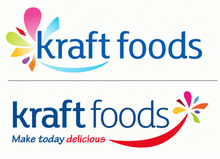 Earnings at Kraft Foods Group, Inc. during fiscal 2012 fell nearly 8% while sales eased 2%. Net income in the year ended Dec. 29, 2012, was $1,642 million, equal to $2.77 per share on the common stock, down from $1,775 million, or $3 per share, in fiscal 2011. Net revenues totaled $18,339 million, down from $18,655 million. The spin-off of Kraft by Mondelēz International, Inc. was completed on Oct. 1, 2012.
Earnings at Kraft Foods Group, Inc. during fiscal 2012 fell nearly 8% while sales eased 2%. Net income in the year ended Dec. 29, 2012, was $1,642 million, equal to $2.77 per share on the common stock, down from $1,775 million, or $3 per share, in fiscal 2011. Net revenues totaled $18,339 million, down from $18,655 million. The spin-off of Kraft by Mondelēz International, Inc. was completed on Oct. 1, 2012.Kraft’s fiscal fourth-quarter financials reflect the company’s standalone cost structure, whereas fourth-quarter fiscal 2011 financials are on a carve-out basis. During the most recent fourth quarter, net income was $89 million, or 15c per share, down 72% from $319 million, or 54c per share, in the same period a year ago. Net revenues fell 11% to $4,494 million from $5,034 million.
“The fourth quarter was one of real progress, and some significant disappointment,” Tony Vernon, chief executive officer of Kraft, said during a Feb. 15 conference call with analysts. “We made great strides in productivity, profit, and cash, but we really missed our top line. At the same time … we feel very good about the solid foundation we laid for the future of the new Kraft.”
Mr. Vernon said the best proof that Kraft is on the right path may be found in the continued growth in some of the company’s iconic brands. He said Kraft Macaroni and Cheese revenues were up 11% in 2012, while Velveeta increased 12%. Sales of MiO, which is in year two of its launch, increased 67% despite stepped-up competition from private label. The cheese and dairy business unit delivered “its best performance in over a decade on all key financial and share measures,” Mr. Vernon said.
Organic net revenues in Kraft’s operating segments were a mixed bag in fiscal 2012 when compared with fiscal 2011. Gains were scored in Cheese, up 2% to $3,833 million; Grocery, up 1% to $4,548 million; International & Foodservice, up 0.8% to $3,836 million; and Refrigerated Meals, up 0.3% to $3,296 million; but fell 5% in the Beverages segment to $2,734 million.
In addition to the release of its financials, Kraft unveiled a new, comprehensive strategy for post-employment benefits designed to improve transparency, simplify accounting, and reduce funding volatility.
Tim McLevish, executive vice-president and chief financial officer, elaborated on the strategy during the conference call. First, the company will move to mark-to-market accounting for post-employment benefit obligations, a move he said will lower Kraft’s ongoing post-employment benefit expenses by eliminating the amortization of unrecognized deferred costs. He said the company will review the liability in the fourth quarter each year, and record any mark-to-market adjustments necessary.
“The entry we record in the fourth quarter for each year will reside outside of segment operating income, and will be identified separately to reflect the pure mark-to-market impacts,” he said.
A second strategy to be put in place will be a one-time adjustment to the actuarial assumptions Kraft used to value plan obligations. Specifically, the company has adjusted retirement, mortality and medical cost trend rates to reflect the expanded population now covered under the company’s plans, Mr. McLevish said.
“On its own, adjusting the actuarial assumptions … will increase ongoing expenses, but we expect it will reduce expense volatility over time,” he said.
Third, Kraft is phasing in a liability-driven investment mix in its pension plans.
“We will do this by migrating from a roughly 30% to 70% fixed income to equity mix to about an 80% fixed income 20% equity mix over the next several years,” Mr. McLevish explained. “As a result, we’ll be adopting a more conservative end state expected return on asset assumption of approximately 5.5%, down from 7.75% previously.”
The final post-employment benefit strategy will be a level funding strategy for pension obligations. Mr. McLevish said Kraft plans to make a $600 million contribution in 2013.
“Since we generated significant cash in 2012 and ended the year with almost $1.3 billion of cash on the balance sheet, funding this will not be a problem,” he said. “Going forward, our strategy is to make level funding contributions of approximately $225 million annually. Our strong cash generation will be more than enough to provide for this.”
Mr. McLevish said the new strategy has several benefits.
“First, we believe these changes will result in a more consistent and predictable financial profile,” he said. “Our ongoing post-employment benefit obligations will be less sensitive to changes in discount rates. And there will be greater transparency to market-based impacts on the size of our liabilities. In addition, the strategy strengthens the alignment between our cash flow and expenses in a manner that should reduce the volatility of cash contributions to plans going forward.
“Lastly, our investment strategy will bring plan assets and liabilities into better alignment, specifically, we’re migrating the asset mix of the plans such that plan assets and plan obligations will fluctuate in tandem. And I would note that this investment strategy will neither affect our debt covenants nor our ability to continually grow our dividend. These changes will not only affect our reported financials going forward, but will also require an adjustment to our historical financials.”





